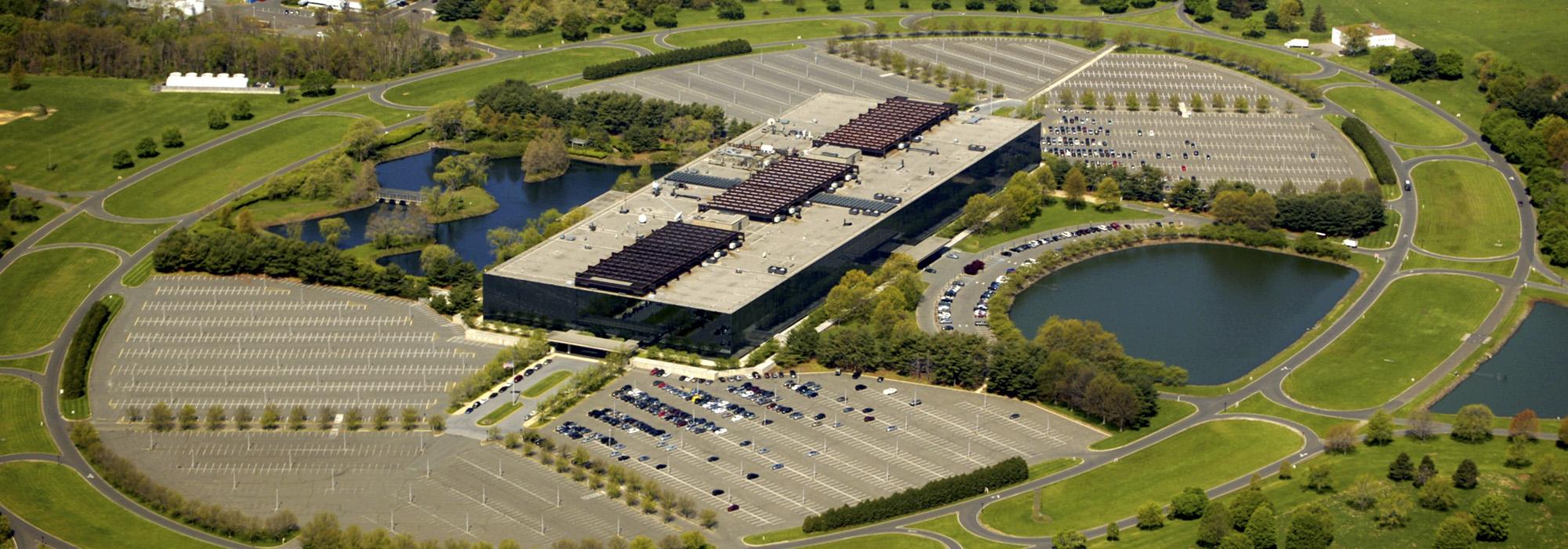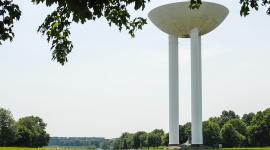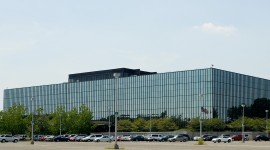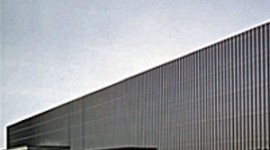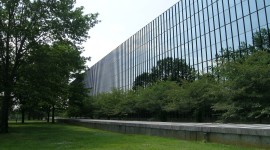Bell Labs: Birthplace of the Transistor and Cell Phone at Risk
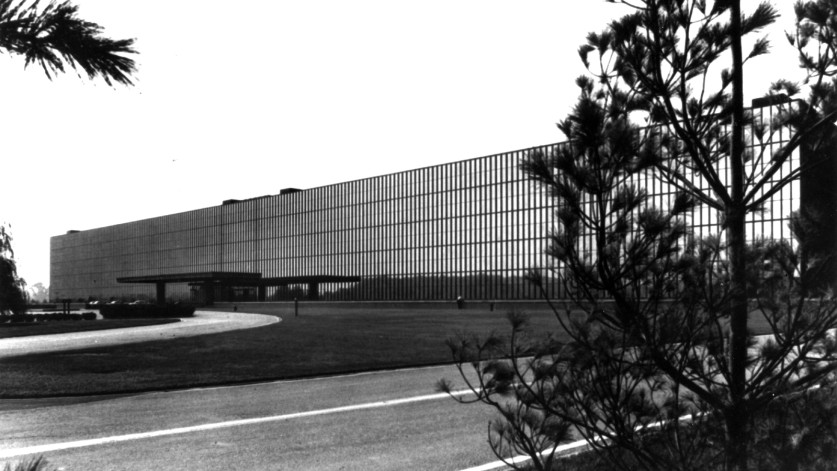
The massive Bell Laboratories complex (1959 to 1962, expanded 1966 and 1985), situated on 472 acres in Holmdel, Monmouth County, New Jersey, is threatened by new development that may destroy or significantly damage the massive historic building and its historic designed landscape.
A new owner is about to take possession of the two million square foot facility, designed by internationally renowned architect Eero Saarinen for Bell Telephone when the company decided to move its laboratory facilities in Lower Manhattan to the site about fifty miles from New York City. Saarinen collaborated with Sasaki, Walker and Associates on design of the corporate campus. Stuart Dawson, FASLA, was with the office during this work, and again with Sasaki, Dawson, and DeMay in 1981-1982, when the firm was brought back to work with architect Kevin Roche. The work done by Sasaki over two decades is not as well known as their work in Moline, Illinois (again with Saarinen) for the much celebrated John Deere & Company headquarters. Perhaps one of the reasons for this is Bell Labs could not be photographed historically for reasons of security.
The stunning example of Mid-Century Modern architecture is clad in mirrored glass, a material developed for the project, leading Architectural Forum to call the building "The Biggest Mirror Ever." The mirrored glass allows 25 percent of the available sunlight to pass through, while blocking 70 percent of the sun’s heat. The glass was meant to reflect the surrounding landscape and pond and make the building “disappear into the landscape” from some vantages at certain times of day. A glass-covered space frame of heat-absorbent, self-oxidizing steel encloses the spaces between four discrete and nearly identical rectangular structures to create a 100-by-700-foot atrium 70 feet high.
As home to Bell Labs for nearly half a century, the site spurred technological advancements that have literally shaped our world, such as the transistor and the cell phone. Bell Labs was home to the work of six Nobel Prize laureates, and the site of the creation of radio astronomy by Karl Jansky in 1932.
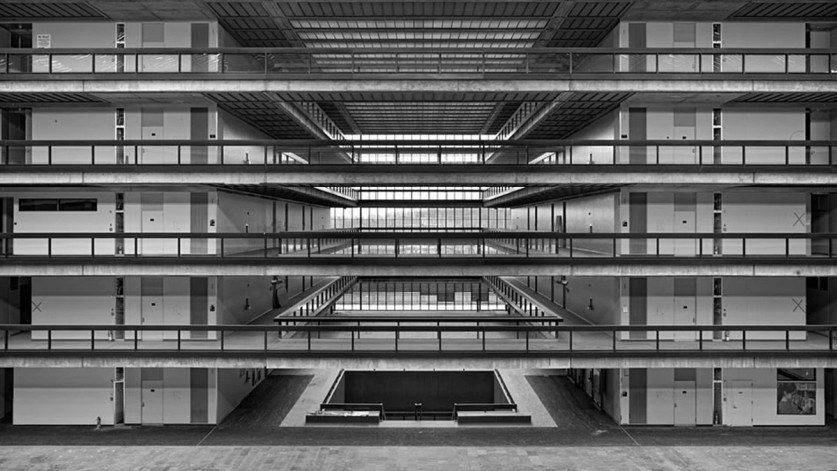
In March 2006 present owner Lucent announced that Preferred Real Estate Investments (PREI) of Conshohocken, Pa., a private developer, had signed a contract to purchase the property. When the developer declared that they intended to raze the building because it was obsolete, there was a storm of protest from scientists from all over the world who had once worked there.

An influential local environmental advocacy group, the Citizens for Informed Land Use (CILU), proposed that the developer save the original core Saarinen building, which consists of the Phase I section and the Atrium, representing approximately one third of the present building. PREI’s chief executive agreed but said that it would have to be gutted and renovated from the inside out, and that all new thermal pane mirrored glass would have to be installed on the exterior. The Saarinen building would act as a “screen” for the smaller corporate headquarters-type buildings that are proposed to be added within the ring road.
Now, the developer has announced a new plan that would preserve only the original 1959/62 portion of the building while inserting new corporate office park-style structures within the surrounding ring road and constructing up to 300 new homes on both sides of the long access road into the property.
The Bell Labs property is zoned for low-density coverage in order to preserve a major groundwater recharge area. The local citizens group warns that additional disturbance of the Bell Labs property, which is located in Holmdel’s “Greenway Corridor,” could have a significant negative impact on the watershed feeding into the Swimming River Reservoir, the source of drinking water for more than 250,000 citizens of Monmouth County. Not only is this a serious threat to the watershed, but also to significant work of landscape architecture designed by the Sasaki office to harmonize with that of rural Holmdel.
Preservation New Jersey (PNJ) the statewide historic preservation advocacy group, listed the Bell Labs building as one of its 10 Most Endangered Historic Sites in New Jersey in May 2007.
Difficult decisions lie ahead for Holmdel. A local Citizens Committee, appointed by the Holmdel mayor, has been studying the proposals and is charged with advising the town council on potential solutions.
Preservation New Jersey, along with the National Trust for Historic Preservation, DOCOMOMO (DOcumentation and COnservation of buildings, sites and neighborhoods of the MOdern MOvement), CILU, the Recent Past Preservation Network, AIA-New Jersey, and the Cultural Landscape Foundation have come together to propose an educational outreach effort to help Holmdel residents and leaders better understand the importance of the historic architecture and landscape of the Bell Labs site, and to explore more creative ways of adapting the Bell Labs building and its historic context for an appropriate and economically viable future while protecting the larger open space and watershed areas.
Get Involved
Interested groups and individuals can call or write the mayor of Holmdel, Serena DiMaso, and the CEO of Preferred Real Estate Investments, Michael G. O’Neill, to express their concern and support for maximum preservation of the Bell Labs buildings and landscape. For more information about the public education and design “charrette” project, contact Preservation New Jersey.



